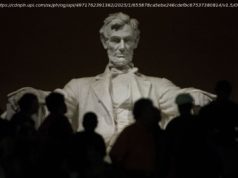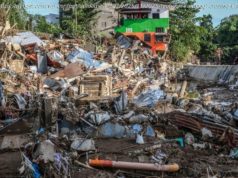The search was on for seven US sailors missing after an American warship and a merchant vessel collided off the coast of Japan, as US forces and Japanese authorities worked to figure out why the vessels struck each other.
“This has been a difficult day, ” Vice Adm. Joseph P. Aucoin, commander of the US 7th Fleet, said.
Forces overnight intensified their search for the missing sailors and tried to get a handle on the cause of a crash in a busy maritime zone crossed daily by 400 to 500 ships.
US and Japanese crafts scoured the spot where the collision happened, about 56 nautical miles southwest Yokosuka and 12 miles off the Izu Peninsula.
The missing sailors could be trapped in a damaged section of the destroyer, a statement from the 7th Fleet suggested.
“It remains uncertain how long it will take to gain access to the spaces once the ship is pier side … to methodically continue the search for the missing, ” the statement said.
A ‘difficult day’ for the Navy
Naval commanders praised the sailors for containing flooding caused by the collision, stabilizing the ship and sailing it back to port at the US naval base in Yokosuka, where divers inspected its damage and developed a plan for repairs and inspection. The ship had left the base on Friday for routine operations.
“The collision affected Fitzgerald’s forward starboard side above and below the water line, causing significant damage and associated flooding to two berthing spaces, a machinery space, and the radio room, ” the 7th Fleet’s statement said.
Fitzgerald’s commander, Cmdr. Bryce Benson, was evacuated by a Japanese naval helicopter while US military copters evacuated two injured US sailors. All three were in stable condition at the US Naval Hospital in Yokosuka, said Cmdr. Ron Flanders, public affairs officer for US Naval Forces Japan.
The Fitzgerald is an Arleigh Burke-class guided-missile destroyer with a crew of approximately 330 sailors. The vessel is 505 feet long.
It completed $21 million in upgrades and repairs in February and is forward-deployed to Yokosuka, supporting security and stability in the Indo-Asia-Pacific region, the service said.
No one hurt on merchant ship
The merchant vessel with which the Fitzgerald collided is the ACX Crystal, a container ship flagged in the Philippines, officials said.
It is chartered by Japanese shipping company Nippon Yusen Kabushiki Kaisha (NYK) and owned by Dainichi-Invest Corporation, NYK said.
No one aboard the Crystal was hurt, and no oil spilled from the vessel, NYK said. It is back in port.
NYK and the ship’s owner are cooperating a Japan Coast Guard investigation into the collision, the shipping firm said.
“Our thoughts and deep concerns go out to all those directly affected, ” NYK said.
The ship-tracking website marinetraffic.com shows the ship left the Japanese port of Nagoya on Friday evening. It was expected to dock at a Tokyo Bay port around 4: 30 p.m. local time, officials said after the wreck.
Photos of the Crystal showed damage to its bow.
The ship, which handles general cargo, is manned by a captain and a crew of 20, NYK said. It was built in 2008 and is about 730 feet long.
Shipping zone can be precarious
The large size of the container ship — it’s almost three times as heavy as the Fitzgerald — may have left the smaller US destroyer vulnerable in the collision, said Carl Schuster, former director of operations at the US Pacific Command’s Joint Intelligence Center and a Hawaii Pacific University professor.
In such a busy shipping lane, the vessels may have been in a “restricted navigation” situation, meaning they would have had to observe strict rules for movement and positioning in relation to other nearby vessels, he said.
Those rules leave little room to maneuver, as turning away from one ship could place a vessel at risk of an even more serious incident with another, Schuster said.
The force of the impact may have thrown overboard sailors who were standing on side of the destroyer opposite where it was struck, he said.
That could account for the missing sailors, who may have been on watch on deck or even just relaxing in the night air, he said.
Sailors also may have gotten trapped in compartments below deck, Schuster said, pointing out that container ships have a bulbous bow below the water line that could have plowed into the US warship.
The last known fatal incident in the zone was in 2015, when a South Korean vessel and a Japanese container ship collided, Japan’s coast guard reported. Six Japanese crew were declared dead.
In January, the USS Antietam ran aground while anchoring near Yokosuka.






